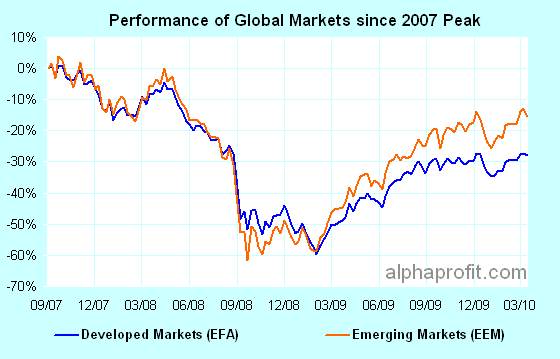Investing Options, Asset Allocation, and more …
Emerging markets ETFs and mutual funds declined 67% from their 2007 peak to their trough in 2008 and have recovered strongly since then. The iShares MSCI Emerging Markets Index ETF (EEM) needs to advance just 22% to scale back to its 2007 high.
While developed foreign markets suffered slightly less than emerging markets during the deep global recession losing 62% from peak to trough, they have lagged emerging markets during the recovery. The iShares MSCI EAFE Index ETF (EFA) now needs 39% to catch up its 2007 high.
The reasons for emerging markets mutual fund and ETFs leading the recovery include fiscal fitness and growth prospects of emerging economies as well as corporate profitability of companies domiciled in emerging economies.
- Fiscal fitness: External debt for the emerging market members of the G20 group of nations is only 36% of gross domestic product (GDP) compared to 327% for the group of G7 developed nations.
- Growth prospects: Emerging economies are expected to grow 4.5% in 2010, 2.7% more than the 1.8% growth expected in developed economies.
- Corporate profitability: Companies in the MSCI Emerging Markets Index have a Return on Equity (ROE) of 17.4%, well above the 12.2% ROE for companies in the MSCI EAFE Index.

Emerging markets ETFs and mutual funds have recovered more rapidly than developed market investments from their recession lows.
Top Emerging Market ETFs and Mutual Funds
Here is a list of some top emerging market ETFs and mutual funds across different asset classes:
Top Currency, Bond, and Stock ETFs & Mutual Funds for Investing in Emerging Markets
Currency ETFs
Stock ETFs and Mutual FundsDiversified Emerging Markets
Country Investments
|
Bond ETFs and Mutual Funds
Stock ETFs and Mutual FundsRegional Investments
Thematic Investments
|
Additionally, ADRs of several leading companies domiciled in emerging markets trade on U. S. exchanges. Here is a sampling of leading companies in the BNY Mellon Emerging Markets 50 ADR Index (BKTEM):
- Petrobras, PBR
- Taiwan Semiconductor Manufacturing, TSM
- China Mobile, CHL
- America Movil, AMX
- Infosys Technologies, INFY
Investing in Emerging Markets – How much is Right?
Emerging market companies make up 20% of total global market capitalization and emerging economies make up nearly 27% of global GDP. Harvard and Yale Endowments have found emerging markets investments compelling enough to allocate 30% of their equity investments.
While such large allocations may be suitable for some institutions, most individual investors would do well to consider volatility and their capacity to take on roller coaster rides. Over the past two and a half years, emerging market stocks have proven to be nearly 70% more volatile than U. S. stocks and 44% more volatile than developed market stocks. Limiting emerging market exposure to less than 15% of one’s assets may not be a bad idea for most individual investors.
Near-Term Risks for Emerging Market ETFs and Mutual Funds
While it is worthwhile to have a portion of assets invested in emerging market stocks and bonds for the long haul, the near-term outlook for such investments is clouded by inflation concerns.
A quick economic rebound aided by stimulus measures is pumping inflation in many emerging economies including China, India, Vietnam, and the Philippines. Although some countries have raised interest rates and some have pared stimulus measures, inflation is likely to get worse in emerging markets before it gets better.
Stocks and bonds often do not deliver exceptional returns when inflation and interest rates are rising. If emerging market stocks and bonds succumb to this generality, the underperformance of broad emerging market mutual funds and ETFs vis-à-vis domestic investments can continue for a while.
 Sick buying high & selling low? Fed up of the fees you pay? Tired researching investments? End your financial pain now. You have the opportunity to
Sick buying high & selling low? Fed up of the fees you pay? Tired researching investments? End your financial pain now. You have the opportunity to 

 DEC. 1993 to DEC. 2023
DEC. 1993 to DEC. 2023

